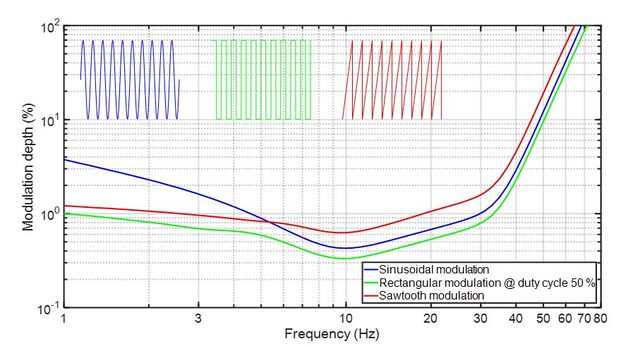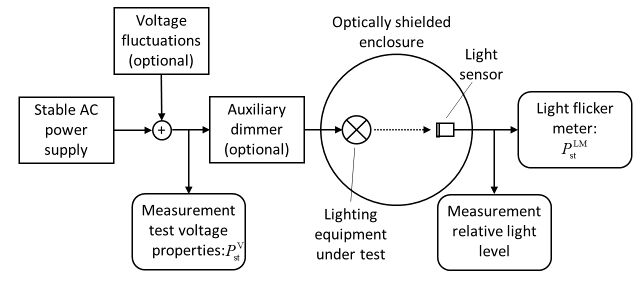Physics:Flicker (light)
In visual perception, flicker is a human-visible change in luminance of an illuminated surface or light source which can be due to fluctuations of the light source itself, or due to external causes such as due to rapid fluctuations in the voltage of the power supply (power-line flicker) or incompatibility with an external dimmer.
Twinkling, also called scintillation, is a generic term for variations in apparent brightness, colour, or position of a distant luminous object viewed through a medium.
Flicker exists for other organisms having different perceptual thresholds.
Light meters and image sensors can potentially detect flicker at much higher frequency bands than human vision. Shutter speeds used in motion photography can interact with high frequency flicker to produce visual artifacts in the captured imagery that betray flicker that would not otherwise be noted.
The spectral sensitivity of the human eye to flicker depends upon the mode of visual perception. Due to the flicker fusion threshold of foveal vision, steady vision can rarely detect flicker above 90 Hz, whereas flicker can be perceived during visual saccades up to or beyond 1 kHz.[1]
Flicker due to mechanical factors such as AC line frequency (typically 50 or 60 Hz) will have a stable frequency structure, whereas the flicker of a damp or failing light bulb will often have a chaotic or erratic frequency structure.
Effects
Various scientific committees have assessed the potential health, performance and safety-related aspects resulting from temporal light modulations (TLMs) including light flicker.[2][3][4] Adverse effects of flicker of include annoyance, reduced task performance, visual fatigue, headache and epileptic attack by photosensitive persons. The visibility aspects of flicker are given in a technical note of CIE; see CIE TN 006:2016.[5] In general, undesired effects in the visual perception of a human observer induced by light intensity fluctuations are called temporal light artefacts (TLAs).
Root causes
Light emitted from lighting equipment such as luminaires and lamps may vary in strength as function of time, either intentionally or unintentionally. Intentional light variations are applied for warning, signalling (e.g. traffic-light signalling, flashing aviation light signals), entertainment (like stage lighting) with the purpose that flicker is perceived by people. Generally, the light output of lighting equipment may also have unintentional light level modulations due to the lighting equipment itself. The magnitude, shape, periodicity and frequency of the TLMs will depend on many factors such as the type of light source, the electrical mains-supply frequency, the driver or ballast technology and type of light regulation technology applied (e.g. pulse-width modulation). If the modulation frequency is below the flicker fusion threshold and if the magnitude of the TLM exceeds a certain level, then such TLMs are perceived as flicker. These TLM-properties may vary over time due to aging effects. Component failure within lighting equipment or end-of-life behavior of lighting equipment can also give rise to flicker.[6] Furthermore, external factors such as incompatibility with dimmers or presence of mains-supply voltage fluctuations (power-line flicker) are root causes of flicker.[7]
Flicker can also be perceived from naturally modulated light sources like candle light or a sunlit water surface or it may be experienced while driving along a row of trees lit by the sun. TLMs and resulting flicker can be seen also while driving with a certain speed along a street or through a tunnel lit by lighting equipment positioned with a regular spacing.[8]
Visibility
Temporal light modulations become visible if the modulation frequency is below the flicker fusion threshold and if the magnitude of the TLM exceeds a certain levels.
There are much more factors that determine the visibility of TLMs as flicker:
- The shape properties of the light waveform (e.g. sinusoidal, rectangular pulse and its duty cycle); see Figure 1;
- The average light level of the light source and its contrast with the background light level within the environment;
- The viewing angle and changes in direction of view by the observer;
- Physiological factors such as age and fatigue.
All observer-related influence quantities are stochastic parameters, because not all humans perceive the same light ripple in the same way. That is why perception of flicker is always expressed with a certain probability. Detailed explanations on the visibility of flicker and other temporal light artefacts are given in CIE TN 006:2016[5] and in a recorded webinar "Is it all just flicker?".[9]
Objective assessment of flicker
Light flickermeter

For objective assessment of flicker, a widely applied and IEC-standardized metric, the short-term flicker indicator (PstLM) is used. This metric is derived from the short term flicker severity metric PstV that is applied in the power quality domain for testing electrical apparatus for their potential to cause flicker via voltage fluctuations on the electrical mains network (see the IEC publications IEC 61000-3-3[10] and IEC 61000-4-15[11]). The short-term flicker indicator PstLM is implemented in a light flickermeter which processes the light measured by means of a light sensor. The light flickermeter[12][13] consists of four processing blocks which include weighting filters to account for frequency dependency of the visibility of TLMs as well as statistical processing to enable assessing a-periodic TLMs. The specification of the light flickermeter and the test method for objective flicker assessment of lighting equipment is published in IEC technical report IEC TR 61547–1.[14]
It is recommended to calculate the value of PstLM using a light waveform recorded for at least three minutes. This enables proper assessment of flicker occurring at low repetition frequencies.
NOTE - Several alternative metrics such as Modulation Depth, Flicker Percentage or Flicker Index are being applied. None of these metrics are suitable to predict actual human perception because human perception is impacted by modulation depth, modulation frequency, wave shape and if applicable the duty cycle of the TLM.
Matlab toolbox
A Matlab light flicker assessment toolbox including a function for calculating PstLM and some application examples are available[15] on the Matlab Central via the Mathworks Community.
Acceptance criterion
The perceptibility scale of PstLM (and PstV) is chosen such that a value of 1.0 corresponds to a level at which 50% of human test subjects judge the flicker to be both noticeable and irritating (Figure 1).

Test and measurement applications
The objective light flickermeter can be applied for different purposes (see Figure 2 and IEC TR 61547-1[14]):
- Measurement the intrinsic flicker performance of lighting equipment when supplied with a stable mains voltage;
- Testing the immunity of lighting equipment against voltage fluctuation disturbances on the AC mains;
- Testing the effect of light regulation of lighting equipment or the effect of an external dimmer (dimmer compatibility).
Publications of standards development organisations
- IEC TR 61457-1:2017:[14] light flickermeter specification and verification method, and test procedure for voltage fluctuation immunity and dimmer compatibility.
- NEMA 77-2017:[16] among others, flicker test Methods and guidance for acceptance criteria.
Ceiling fans and wind turbines
Other examples of light flicker can sometimes be associated with ceiling fans[17] or wind turbines[18] This occurs when the rotation of the blade continuously blocks the light source (i.e. indoor ceiling light or Sun), causing visual flicker.
See also
- Persistence of vision
- Temporal light artefacts
- Temporal light effects
- Power-line flicker
- Power quality
- Flicker fusion threshold
- Flicker problems in fluorescent lamps
- Stroboscopic effect (lighting)
References
- ↑ Wilkins, Arnold J (27 July 2017). "The scientific reason you don't like LED bulbs — and the simple way to fix them". The Conversation. https://theconversation.com/the-scientific-reason-you-dont-like-led-bulbs-and-the-simple-way-to-fix-them-81639. Retrieved 3 August 2021.
- ↑ IEEE Std 1789:2015, IEEE Recommended Practices for Modulating Current in High-Brightness LEDs for Mitigating Health Risks to Viewers (link).
- ↑ SCENIHR (Scientific Committee on Emerging and Newly Identified Health Risks), Health effects of artificial light, 19 March 2012 (Script error: No such module "CS1 identifiers".).
- ↑ SCHEER (EC Scientific Committee on Health, Environmental and Emerging Risks), Final Opinion on potential risks to human health of Light Emitting Diodes (LEDs), June 2018.[1]
- ↑ 5.0 5.1 CIE TN 006:2016, Visual Aspects of Time-Modulated Lighting Systems – Definitions and Measurement Models (pdf).
- ↑ Fluorescent lamp end-of-life flicker problems.Fluorescent lamp
- ↑ R. Cai, Flicker interaction studies and flickermeter improvement, PhD thesis , Eindhoven : Technische Universiteit Eindhoven, 2009.[2]
- ↑ See flicker problems in the Queensway Tunnel.
- ↑ Sekulovski, Dragan; Signify (Apr 4, 2016). "Is it all Flicker?". https://www.youtube.com/watch?v=1gZg6eUmEGA.
- ↑ IEC 61000-3-3 (ed. 3.1), Electromagnetic compatibility (EMC) – Part 3-3: Limits – Limitation of voltage changes, voltage fluctuations and flicker in public low-voltage supply systems, for equipment with rated current ≤ 16 A per phase and not subject to conditional connection.[3]
- ↑ IEC 61000-4-15 (ed. 2), Electromagnetic compatibility (EMC) –Part 4-15: Testing and measurement techniques – Flickermeter –Functional and design specifications.[4]
- ↑ J. Drápela, J. Šlezingr, A light-flickermeter – Part I: Design, Proceedings 11th International Scientific Conference Electric Power Engineering 2010, pp. 453.[5]
- ↑ Lance Frater, Light Flicker and Harmonic Modelling of Electrical Lighting, PhD thesis, University of Canterbury, Christchurch, New Zealand, 2015.[6]
- ↑ 14.0 14.1 14.2 IEC TR 61547-1 (ed. 3), Equipment for general lighting purposes – EMC immunity requirements – Part 1: An objective light flickermeter and voltage fluctuation immunity test method.[7]
- ↑ Light flicker assessment toolbox Matlab Central
- ↑ NEMA 77-2017: Temporal Light Artifacts: Test Methods and Guidance for Acceptance Criteria.[8]
- ↑ Kent, Michael; Cheung, Toby; Li, Jiayu; Schiavon, Stefano (2020). "Experimental evaluation of visual flicker caused by ceiling fans" (in en). Building and Environment 182: 107060. doi:10.1016/j.buildenv.2020.107060. https://escholarship.org/content/qt3wj1f6xj/qt3wj1f6xj.pdf?t=qfkewm.
- ↑ Harding, Graham; Harding, Parmela; Li, Arnold; Wilkins, Stefano (2008). "Wind turbines, flicker, and photosensitive epilepsy: Characterizing the flashing that may precipitate seizures and optimizing guidelines to prevent them" (in en). Epilepsia 46 (6): 1095–1098. doi:10.1111/j.1528-1167.2008.01563.x. PMID 18397297. https://onlinelibrary.wiley.com/doi/10.1111/j.1528-1167.2008.01563.x.
 |
